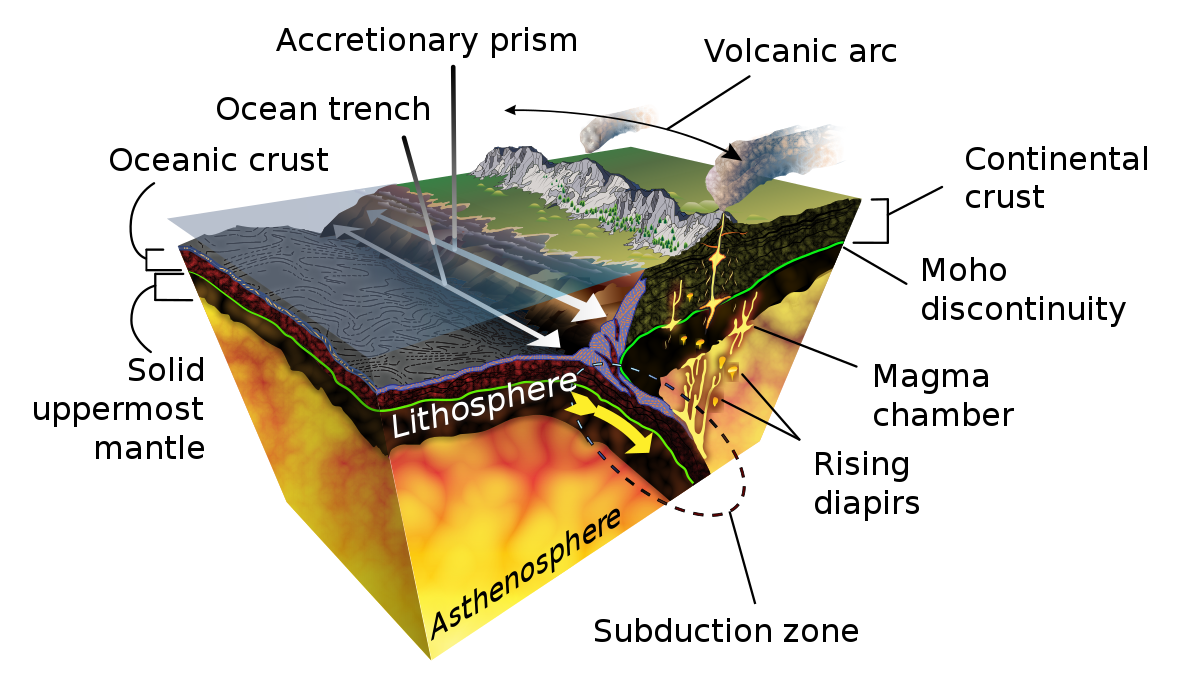|
Volcanism
- About
-
- Volcanism is the eruption of magma onto the surface of the Earth. It is a phenomena associated with the surface discharge of molten rock, pyroclastic fragments, or hot water and steam, including volcanoes, geysers, and fumaroles.
- A volcano is a vent or fissure in Earth’s crust through which lava, ash, rocks, and gases erupt.
- From a human perspective, volcanism can be a destructive force causing property damage, injuries, fatalities, and atmospheric changes.
- From a geologic perspective, volcanism is a constructive process that builds oceanic islands, produces oceanic crust, provides parent material for highly productive soils, and releases the gases that formed Earth’s early atmosphere and surface waters.
- Classification
-
- The volcanoes are broadly classified on the basis of (a) The mode of eruption and (b) The period of eruption. A brief description is as follows:
The mode of eruption further classified into:
- Hawaiian Type: Hawaiian eruptions are the calmest of the eruption types. They are characterized by the effusive emission of highly fluid basalt lavas with low gas contents.
- The relative volume of ejected pyroclastic material is less than that of all other eruption types. For example, the volcanoes in Hawaiian State of USA.
- Strombolian Type: Strombolian eruptions are named from the small volcano-island of Stromboli located between Sicily and Italy. The term “strombolian” has been used indiscriminately to describe a variety of volcanic eruptions that vary from small volcanic blasts, to kilometer-high eruptive columns.
- Vesuvius Type: It is an explosive volcanic eruption which ejects pyroclastic material forming an eruption column which may be up to 55 km high, dispersing ejects over an area of 500–5000 km2.
(b) On the Basis of Period of Eruption
- Active Volcanoes: A volcano is classified as active if it is currently erupting or is expected to erupt in the near future. For example Kilauea, in Hawaii, USA, Barren Island in Andaman, India.
- Dormant Volcanoes: A dormant volcano is one that is not currently erupting but has erupted within recordable history and is expected to erupt again in the future. For example Mauna Kea in Hawaii, USA.
- Dormant volcanoes are often the most dangerous as people are complacent living within their vicinity and are generally unprepared when an eruption does come. This was the case with Mt. St. Helens in 1980.
- Extinct Volcano: Extinct volcanoes haven’t erupted for tens of thousands of years, and aren’t expected to erupt again.
- Some volcanoes look extinct, but it might just be a long time since they’ve erupted. For example, the Yellowstone Caldera in Yellowstone National Park hasn’t had a violent eruption in about 640,000 years, but scientists think it’s still active. Volcanoes thought to be extinct have erupted again.
Distribution of Volcanoes in World
- There are three volcanic belts, besides many volcanoes which are outside these belts. The three volcanic belts are as under:
- The Circum-Pacific Belt: This is the most important belt of volcanoes. This is also called Pacific Ring of Fire.
- The belt extends through the Andes of South America,Central America, Mexico, the Cascade Mountains of Western United States, the Aleutian Islands,Kamchatka, the Kuril Isles, Japan, the Philippines,Celebes, New Guinea, the Solomon Islands, New Caledonia and New Zealand.
- This belt has 80 active volcanoes. The Circum-Pacific belt meets the mid-continental belt in the East Indies.
- This belt is characterised by high volcanic cones and volcanic mountains. The volcanoes of the Aleutian Island, Hawaii Island and Japan are found in Chains.
- In this belt volcanic eruptions occur because of the subduction of the Pacific plate below the Asiatic plate.
- Mid-Continental Belt: This belt has various volcanoes of the Alpine mountain chain,
- Mediterranean Sea (Stromboli, Vesuvius, Etna etc.), Volcanoes of the Aegean Sea. Mt. Ararat, Elburz andHindukush are also included in this belt.
- Mid-Atlantic Belt: This belt includes the volcanoes of the Mid-Atlantic Ridge. The volcanoes associated with the Atlantic Ocean are located either on swells or ridges rising from the sea floor, or on or near the edge of the continent where it slopes abruptly into the deep oceanic Basins. The volcanoes formed along the Mid-Atlantic Ridge actually represent the splitting zone of the American plate moving towards west and the Eurasian plate moving towards east.

|




